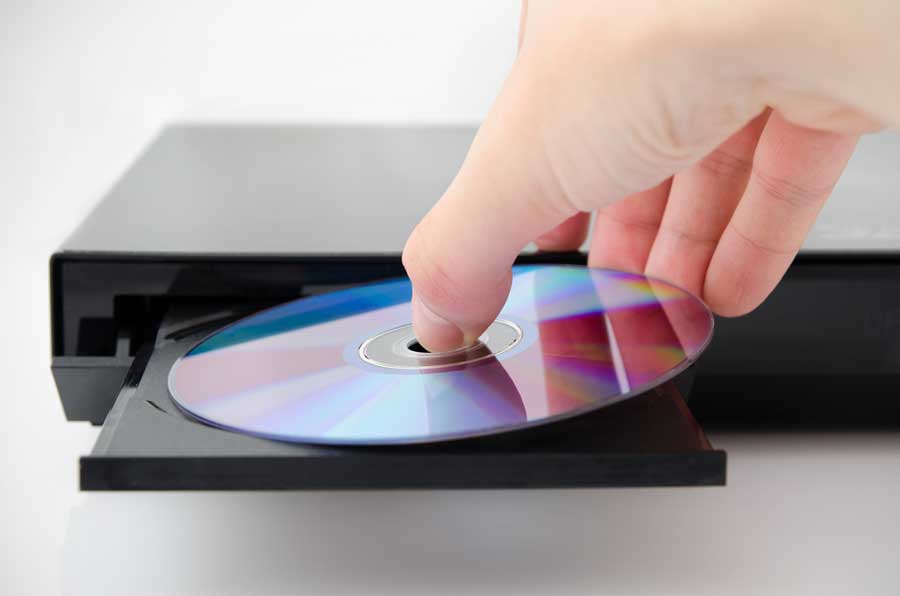Last Updated on June 16, 2023 by Tim Wells
One of the most frustrating things about new video formats is having to re-buy all of your old movies again.
Not to date myself, but I’ve done that a few times already, switching from VHS to DVD and again to Blu-ray. With 4K UHD Blu-rays on the market, do we need to upgrade again?
In this article, I’m going to go through the significant differences between DVDs, Blu-ray, and 4K UHD and what they mean for your movie collection.
We’ll look at each format in terms of the picture quality you can expect, cost, and whether you might need to buy new hardware to play them.
Finally, we’ll figure out if you really need to upgrade.
Let’s get started.
Blu-ray vs DVD vs 4K UHD: Overview
Generally, movies and TV shows on DVD movies will be less expensive than their Blu-Ray and 4K UHD counterparts.
They may not have higher-end audio tracks such as Dolby Atmos or DTS. Most modern movies are released on Blu-ray due to the higher resolution (1080p vs 480p).
Only big blockbuster movies are released on 4K UHD due to the higher cost and limited consumer demand.
| DVD | Blu-ray | 4K UHD | |
| Resolution | 480p | 1080p | 2160p (4K) |
| Storage | 4.7GB | 25GB | 66GB |
| Availability | High | High | Low |
| Cost (New Releases) | $15-$20 | $20-$25 | $30-$35 |
Blu-ray vs DVD vs 4K UHD: Picture Quality and Resolution
Picture quality and resolution are the first significant difference between these three formats.
In other words, how sharp is the picture? How good will it look on your screen?
DVD
A DVD has the lowest resolution of all three formats, with 720 pixels by 480 pixels (720×480). This is also referred to as 480p.
If you think about it this way, older tube televisions (CRT) usually have roughly the same resolution. However, they’re typically 480i (interlaced) instead of 480p (progressive scan).
Even the oldest HDTV has a better resolution!
So if you buy a DVD for the story, you’ll get what you need. But, if you’re looking for the best picture quality, you should be looking at least at Blu-ray discs.
Blu-Ray
A Blu-Ray disc is the next evolution of a DVD. Blu-Ray discs can display at 1920 pixels by 1080 pixels (1920×1080).
Each row is displayed individually in sequence, which is called progressive scanning. That’s where the ‘p’ in 1080p comes from.
If you multiply all those pixels together, you’ll see that the Blu-Ray displays nearly six times the amount of pixels as a DVD. That makes for a much denser, deeper, and better-looking picture.
Most high-definition televisions sold today display at 1080p, so they’re an excellent match for Blu-Rays. If you have an older 720p HDTV, Blu-Rays will still look great on them.
I wrote an article outlining the differences between 720p and 1080p here. There you can see if it makes a difference based on the size of your TV and how far away you’re sitting from it.
4K UHD
4K UHD discs are the newest and most sophisticated of the three formats. These discs display on-screen at 3,840 pixels by 2,160 pixels (or 2160p).
That amount of pixels is 4 times what you would find on a Blu-Ray disc, which means it’s nearly 30 times higher than a DVD!
4K UHD discs are currently the top choice for picture clarity. Watching a 4K UHD movie can feel more like looking through a window than watching a movie. However, not all movies are available on 4K UHD discs.
4K UHD discs will be displayed on an HDTV, but they’re made for a 4K television.
Check your settings if you’re unsure what kind of television you have.

Blu-ray vs DVD vs 4K UHD: Hardware Compatibility
Have you ever heard the term, “All beagles are dogs, but not all dogs are beagles?”
Disc format compatibility works the same way.
DVD
If you’re looking at a disc player, computer, video game console, or even a car that has a disc drive, there’s an excellent chance that it will play a DVD.
DVDs have been the dominant format since the beginning of the 21st century for movies, television shows, and software.
The great thing about DVDs is that modern hardware will work backward. So, if you have a Blu-Ray or a 4K UHD disc player, it will also play DVDs with no problem.
Blu-Ray
Blu-Rays have been around since roughly 2005, so finding a Blu-Ray player these days is also no problem.
If you own a video game console like the PlayStation 3, Xbox 360, PlayStation 4, or Xbox One, those also can act as Blu-Ray players.
Blu-Ray players will be able to handle Blu-Ray discs and DVDs.
However, if you put a 4K UHD disc in, it will not work. Similarly, if you put a Blu-Ray disc into a DVD player, it also will not work.
4K UHD
4K UHD has been around for more than a decade, so getting a 4K UHD disc player is pretty straightforward. However, they are still more expensive in most cases than a DVD or Blu-Ray player.
You also have a ready-made 4K UHD disc player if you have a current-generation gaming console like the Xbox Series S or X or the PlayStation 5!
These discs will only play in a 4K UHD player, so if you try to play them on a DVD or Blu-Ray player, they will not work.
A 4K UHD player, though, will play all formats.
If you’re in the market for a disc player, know what you’re getting. If you’re not sure, ask!
Without a 4K-capable television, you won’t get the most out of a 4K disc player, so a Blu-Ray player should work fine.
If you have the right television or think you might in the future, consider a 4K UHD disc player. It is a little more expensive upfront but supports all other formats, so it should last longer.
Blu-ray vs DVD vs 4K UHD: Uses and Storage
Any of these three formats can store data or create your own movies or picture discs. Many chain stores or electronic stores sell blank versions.
DVDs come in two varieties: single- and dual-layer. A single-layer DVD comes with 4.7 GB (gigabytes) of storage, and a dual-layer comes with 8.5 GB. The label on the case or DVD itself will tell you which version you have.
Similar to DVDs, Blu-Ray discs also come in two sizes. The standard single-layer has 25 GB available, while the dual-layer has 50 GB.
4K UHD discs come in three sizes. The smallest is 50 GB, the middle is 66 GB, and the highest is 100 GB. The most significant difference between a 4K UHD disc and a Blu-Ray, though, is the data rate. We won’t get too technical here, but the UHD disc can transfer more data per spin than the Blu-Ray disc, which allows it to work faster and contain more.
Please note that if you want to create (burn) your own DVD, Blu-Ray, or 4k UHD disc, you will need a piece of hardware called a disc burner.
DVD burners are cheap, but you wouldn’t be able to burn a Blu-Ray or 4K UHD disc. 4K UHD burners are more expensive (but getting cheaper all the time), but you’d be able to burn any of the three formats.
Blu-ray vs DVD vs 4K UHD: Availability
All three formats are readily available. They were harder to find when Blu-Rays and 4K UHD were new. This is because the production costs were higher, and new formats didn’t have a vast DVD library. However, any large brick-and-mortar store or online retailer will likely have all three formats available.
If you want your disc library to be complete, focus on DVDs or Blu-Rays.
This is simply because they have been around for the longest and have the most extensive libraries. It is also significantly cheaper and similar for smaller, independent filmmakers to release a DVD or Blu-Ray than a 4K UHD disc, so, even today, those kinds of movies are easier to find on DVD.
However, if your collection is focused on newer releases, look at Blu-Ray or 4K UHD. More modern releases will often (but not always) get a DVD release. Still, things like picture options and special features are often stripped out.
How can you know what kind of disc you’re getting for large stores that carry all formats?
Fortunately, manufacturers have made that pretty easy. 4K UHD disc boxes generally say 4K at the top. Blu-Ray boxes are generally blue and have a large B. DVD boxes will say DVD. Again, if you’re not sure, ask for support.
Blu-ray vs DVD vs 4K UHD: Cost
Cost is another important difference between the three formats.
The distinctions can look large, but you can make that difference much smaller if you’re patient or willing to dig.
DVD
In general, DVDs are the cheapest. Whether thinking about hardware, movies, or blank DVDs, they are all relatively inexpensive. A new movie can generally be found for roughly $10-15.
However, because DVDs have been around for so long, you can find used DVDs for significantly cheaper.
Used copies of even popular movies can often be found on Amazon and eBay for as little as $1. Some online retailers will also sell DVDs in lots, allowing you to build a great collection quickly.
Blu-Ray
Blu-Rays are more expensive than a DVD, but not by too much. If you wanted to buy a Blu-Ray movie on the day of release, you could expect to pay roughly $20-25.
However, prices fluctuated a lot before release, so you might get lucky and get it for cheaper than that.
Similar to DVDs, though, because Blu-Rays have been around for more than a decade, both new copies of older releases and used copies of many things are incredibly affordable.
Prices will vary depending on whether the disc is still in print. Still, many releases can be found online for approximately $5.
4K UHD
Because they’re the newest, 4K UHD discs will tend to be the most expensive.
Many new releases will be available for between $30-40. However, some releases (such as special editions or Director’s Cuts) will be almost twice that.
If you’re willing to wait a bit, 4K UHD discs tend to come down in price fairly quickly after release.
Used copies are available, but we recommend keeping an eye on sales to build your collection and save a little money in the process.
- How to Install Kodi Diggz Xenon Plus & Free99 Build [March 2024] - March 3, 2024
- How to Enable Unknown Sources on Chromecast with Google TV [2024] - October 30, 2023
- How to Install the Seren Kodi Addon [2024] - October 29, 2023

